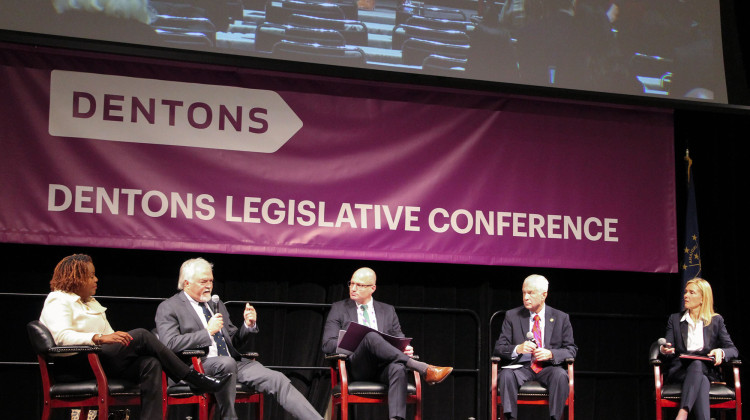Members of the Indiana 2020 Two-Way asked us about what work might look like as Indiana slowly reopens sectors of the economy. To join, text “elections” to 73224.
So, Indiana Public Broadcasting and All IN went to work to answer some of those questions by gathering a panel of experts, including: Justin Hicks, IPB News workforce reporter; Teresa Stewart, a service technician and member of the Service Employees International Union; Paul Nappier, an organizer for SEIU Local 1; and David Krause, a toxicologist and certified industrial hygienist.
READ MORE: Can I Go For A Walk? Here's What The Updated 'Stay-At-Home' Order Really Does
Join the conversation and sign up for the Indiana 2020 Two-Way. Text "elections" to 73224. Your comments and questions in response to our weekly text help us find the answers you need on COVID-19 and the 2020 election.
LEE MAS: ¿Puedo Salir A Caminar? Esto Es Lo Que Significa Una Orden De Permanecer En Casa
How can workplaces protect their workers from COVID-19?
David Krause is an industrial hygienist – someone who focuses on health and safety in the workplace. He previously served as the Florida state toxicologist and is currently the chairman of the American Industrial Hygiene Association's indoor environmental quality committee.
“What we’re looking at here is a lot of uncharted territory,” Krause says. “And don’t let anybody tell you they’ve got the answer to every situation.”
Krause says employers cannot wait for government guidance on how to protect employees. Often he says what is being provided is so vague that it isn’t helpful or it’s designed for workplaces that public officials are familiar with.
“Employers and employees should not wait upon clear guidance from public health officials or occupational health officials – that will never come,” Krause says.
He says things like gloves and masks are pretty base-level. Business owners need to think through avoiding exposure, even as employees return to work. Krause says designing a work schedule to avoid getting cramped up together – like what time people come into work – can help lower the risk of exposure.
And in addition to regular workplace cleaning, Krause says there are engineering changes businesses need to think through.
“Automatic or sensored doorways, so people aren’t touching the door handle every five minutes,” Krause says. “These type of things can be used to reduce people’s exposure with people not even realizing it.”
He says layering these kinds of measures on top of providing PPE is a much better approach than relying solely on masks and gloves.
Are enough businesses prepared to take the precautions they need to, right now? What does the workplace safety situation look like, generally?
Krause says no. Businesses aren’t following the rules and best practices for workplace safety outside of a global pandemic. He says that’s because funding for state and federal occupational health and safety administrations aren’t enough to keep up with businesses.
He says businesses may need to model after hospital infection control and environmental services, which focus not only on cleanliness but also on sanitization.
Last week the governor asked businesses to send him feedback on whether they think they can reopen safely. What do we know about the response he got?
Justin Hicks says there still aren’t a lot of details. One of the few specific industries to provide feedback is the Indiana Manufacturer’s Association.
It recommends every facility have a workforce safety plan. It also asked the state for clearer guidance on how to safely operate businesses – but that those rules don’t include new regulations.
Hicks says most industries have told the governor they want to reopen. The governor has said it’s a matter of how they can do that safely.
If businesses aren’t able to adjust, what can we anticipate in states that are reopening?
Krause is based in Tallahassee, Florida, and often crosses the border into Georgia. He says some of the decisions – especially in Georgia – don’t make sense to him.
“We will move forward in fits and starts,” Krause says. “We will see a rise in cases. It’s going to happen. We are artificially throwing people together without sufficient supplies, equipment, training and plans; leaving it up to operations and facilities who have never done this before to design, implement programs to protect people from something they can’t see.”
He says employers and employees need to act as if every person they interact with is infected, in order to effectively protect themselves.
What should employees ask for when returning to work?
Paul Nappier, an organizer for SEIU Local 1 in Indianapolis, says all workers have a right to feel safe at work and to not worry about bringing home a deadly virus to their families.
He points to things like paid sick leave, health insurance and transparency on how employers are sanitizing workplaces.
What directions has the state given to employers about how to reopen?
Hicks says the governor hasn’t released any new guidance, and that he expects some of that to come out on Friday, May 1. But, going through the guidance offered to essential businesses from a previous executive order, he says you can get a pretty good guess as to what the governor is going to recommend.
Hicks says it’s unlikely that employees already working from home will be brought back to the office any time soon. The governor’s previous executive order encouraged employers to have as many employees working from home as possible.
The previous executive order also outlines encouraging sick employees to stay home, maybe having temperature checks before coming into work, and being clear about what the business is doing to protect health and the expectations to maintain that.
Will there be a monitoring program to help make sure a food preparation company – like meat processing plants – are following safety guidelines?
Hicks says he hasn’t heard of anything on the state level, even as the federal Department of Labor has provided guidance for meat processing plants. Krause says, “there’s absolutely no way they could do a monitoring program.”
He says governments don’t have enough resources or tests to make sure that agricultural workers or meat processors are healthy. But, because we cook our food, generally speaking, we’re still safe – there are only a handful of bacteria that survives the cooking process.
How should companies prepare their buildings to reopen?
Krause says there’s a unique challenge to emptying buildings out: it can lead to water-borne pathogens like Legionnaires’ disease.
READ MORE: COVID-19 Closures Could Make Water Unsafe In Offices, Schools
He says he’s concerned about hotels, offices and gyms that have gone dark for a while may lead to stagnant water.
I am at high risk being 72, with diabetes and a blood disorder. We are in shutdown now until May 1. Will it be safe enough for me to return to work after May 1, or should I still work from home?
Hicks says he’s heard a few things while reporting on workforce issues – one specific example involved a woman who was at a higher risk for COVID-19. She found, although her employer had asked her to come into work, she was able to get a note from her doctor to tell her employer it was against medical advice to go in.
That method also helped her receive unemployment insurance benefits, because if someone is quarantined by a medical professional you qualify for unemployment benefits.
Hicks says there may be some resources from the Civil Rights Commission or the Equal Employment Opportunity Commission if you’re in that position.
Contact Lauren at lchapman@wfyi.org or follow her on Twitter at @laurenechapman_.
This is a rapidly evolving story, and we are working hard to bring you the most up-to-date information. However, we recommend checking the websites of the Centers for Disease Control and Prevention or the Indiana State Department of Health for the most recent numbers of COVID-19 cases.
Indiana Public Broadcasting, Side Effects and this station will ask Americans about health issues, as part of the America Amplified: Election 2020 initiative.
 DONATE
DONATE







 Support WFYI. We can't do it without you.
Support WFYI. We can't do it without you.